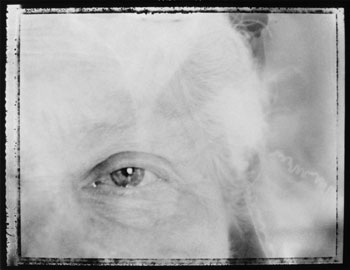Muriel Hasbun
dal 4/9/2003 al 4/10/2003
Segnalato da
4/9/2003
Muriel Hasbun
Conner Contemporary Art, Washington
'Watched Over', an exhibition of new photographs by Washington-based artist Muriel Hasbun. The installation is a continuation of the artist's exploration of cultural heritage and will feature images incorporating her ideas about identity and postmemory.

Conner Contemporary Art is pleased to announce "Watched Over", an exhibition of new photographs
by Washington-based artist Muriel Hasbun. The installation is a continuation of the artist's exploration of cultural heritage and will feature images incorporating her ideas about identity and postmemory.
by Andy Grundberg
Muriel Hasbun is one of a number of young artists, on both continents of the Americas, to have lately focused their art on the emotional complexity and tantalizing inscrutability of cultural heritage. Many of these artists come from backgrounds in which the past has been inextricably and irretrievably severed from the present; they are descendents of Africans brought to the Americas as slaves, for example, or refugees from regimes that sought to obliterate their families. Hasbun's personal circumstances are not as rigidly distanced but even more culturally dizzying; she is the daughter of a Salvadoran man whose parents were Christian Palestinians and of a French-born mother whose family was originally Polish and Jewish. Raised in El Salvador, Hasbun has lived most of her adult life in the United States.
In seeking to come to terms with this heritage, and with its accompanying trunk of family stories, secrets, and memories, Hasbun has found photographs to have a particular resonance. The photographs saved by her parents and relatives, as well as the photographs that she makes of them, provide a seemingly undeniable link to the past, a connection to the "having been there" that Roland Barthes identified as the essential message of a photograph. They are, in short, keys to memory - or to what Hasbun, echoing a term devised by the scholar Marianne Hirsch, calls postmemory. Postmemory can be explained as memory at one or more removes, a kind of distant cousin of experience in which the past of historical fact and the past of metaphor are inextricably combined. What Hasbun makes of her own postmemories is something else, something we might call metamemory because it constitutes a reflection on memory itself, and on the role that memory plays in forming our ideas about ourselves.
The Protegida: Auvergne series, two sections of which are on view here, was inspired by Hasbun's artistic detective work in relation to her great aunt, Hélène, who lived for most of her life in a village in the central French district of Auvergne. The village, not far from Vichy, was where her great aunt, grandmother, and mother had hidden (and been hidden) from the Nazis during the occupation of France. Moved by an apparent combination of altruistic and financial motives the townsfolk, including village officials, let the obviously Polish immigrants assume French identities and sheltered them for the duration of the war. Hasbun's mother, a young child at the time, remembered two significant things from this perilous experience: ballet lessons and the sound of Ave Maria being recited.
Hasbun has collected the memories of wartime France retained by her great aunt and mother and connected them with her own memories of growing up in El Salvador. In the first installment of Protegida, called Toi et Moi she combined photographs taken in El Salvador and France and included volcanic rocks from both countries -- rocks that were virtually indistinguishable from each other and thus spoke to the possibilities of cross-cultural influence. In the installations here, titled Hélène and Ave Maria, photographs of the artist's great aunt and a small chapel in the Auvergne are combined with excerpts from postcards written by her grandfather to her grandmother during the war, as well as with the sounds of Ave Maria and a French children's song that Hasbun learned from her mother. Presented as altar-like triptychs, the photographs ground us in the here-and-now, but they also require us, intellectually and emotionally, to be in two places at once.
Hasbun's artistic language is characteristically a form of collage, in which elements of different places, times, and mediums are brought onto a single surface, but the photographs have more in common with the phenomenon of pentimento, in which old oil paint fades to reveal an earlier layer of drawing underneath. The difference between the drawing and the painting on top of it is thought to represent the painter's change of mind, or "repenting." In Hasbun's case, we might think of pentimento as a metaphor of memory, of the intimate distance between the tracings of personal history that families carry from generation to generation and the fuller, more dimensional and multi-hued constructions of individual identity that we create from those barely discernible lines. We are "watched over" (the meaning of "Protegida," literally) by these memories, much as Hasbun watches over these photographs and, in turn, is watched over by them.
Hasbun is currently exhibiting "Watched Over" ( Spanish translation - "Protegida" ) at the 50th Venice Biennale where she represents El Salvador in the Latin American Pavilion (through November 2, 2003).
There will be an opening reception for the artist at Conner Contemporary Art on Friday, September 5th from 6 -8pm. Muriel Hasbun will discuss her work in a gallery talk at Conner Contemporary Art on Saturday, September 6th at 2:30pm.
Conner Contemporary Art
1730 Connecticut Avenue, NW - 2nd Floor
Washington, DC 20009
Tel. + 202-588-8750



